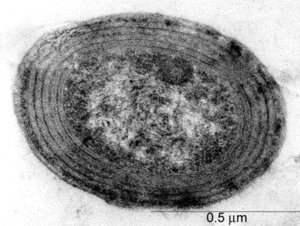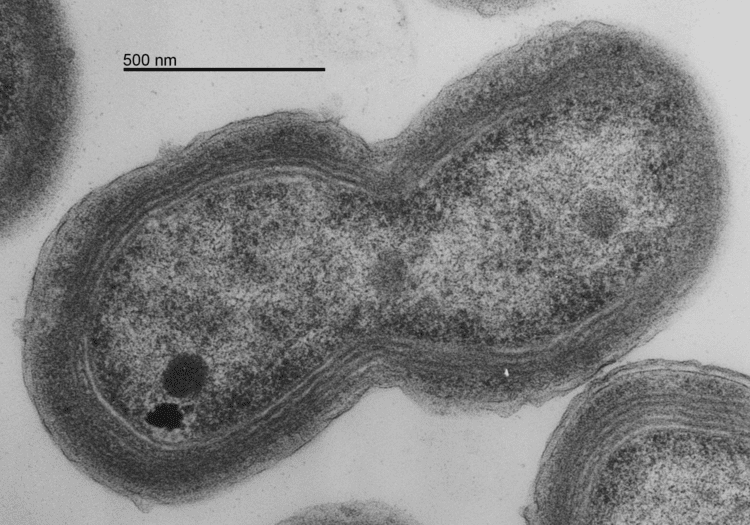Scientific name Prochlorococcus Higher classification Synechococcaceae | Rank Genus | |
Similar Synechococcus, Blue‑green bacteria, Bacteria, Prochlorophyta, Picoeukaryote | ||
Prochlorococcus med4
Prochlorococcus is a genus of very small (0.6 µm) marine cyanobacteria with an unusual pigmentation (chlorophyll b). These bacteria belong to the photosynthetic picoplankton and are probably the most abundant photosynthetic organism on Earth. Microbes of the genus Prochlorococcus are among the major primary producers in the ocean, responsible for a large percentage of the photosynthetic production of oxygen. Analysis of the genome sequences of 12 Prochlorococcus strains show that 1100 genes are common to all strains, and the average genome size is about 2000 genes. In contrast, eukaryotic algae have over 10,000 genes.
Contents

Discovery

Although there had been several earlier records of very small chlorophyll-b-containing cyanobacteria in the ocean, Prochlorococcus was discovered in 1986 by Sallie W. (Penny) Chisholm of the Massachusetts Institute of Technology, Robert J. Olson of the Woods Hole Oceanographic Institution, and other collaborators in the Sargasso Sea using flow cytometry. The first culture of Prochlorococcus was isolated in the Sargasso Sea in 1988 (strain SS120) and shortly another strain was obtained from the Mediterranean Sea (strain MED). The name Prochlorococcus originated from the fact it was originally assumed that Prochlorococcus was related to Prochloron and other chlorophyll-b-containing bacteria, called prochlorophytes, but it is now known that prochlorophytes form several separate phylogenetic groups within the cyanobacteria subgroup of the bacteria domain.
The only species of the genus that has been described is Prochlorococcus marinus.
Morphology

Marine cyanobacteria are to date the smallest known photosynthetic organisms; Prochlorococcus is the smallest at just 0.5 to 0.8 micrometres across. The coccoid shaped cells are non-motile and free-living. Their small size, thus large surface-area-to-volume ratio, gives them an advantage in nutrient poor water. Still, it is assumed that Prochlorococcus have a very small nutrient requirement. Typically, Prochlorococcus divide once a day in the subsurface layer or oligotrophic waters.
Distribution

Prochlorococcus has been found to be abundant in the euphotic zone of the world's tropical oceans. It is possibly the most plentiful species on Earth: a single millilitre of surface seawater may contain 100,000 cells or more. Worldwide, the average yearly abundance is between 2.8 and 3.0 octillion (~1027) individuals (for comparison, that is approximately the number of atoms in a ton of gold). Prochlorococcus is ubiquitous between 40°N and 40°S and dominates in the oligotrophic (nutrient poor) regions of the oceans. Prochlorococcus is mostly found in a temperature range of 10-33 °C and some strains can grow at depths with low light (<1% surface light). These strains are known as LL (Low Light) ecotypes, with strains that occupy shallower depths in the water column known as HL (High Light) ecotypes. LL type Prochlorococcus have a higher ratio of chlorophyll b to chlorophyll a, which aids in their ability to absorb blue light. Blue light is able to penetrate ocean waters deeper than the rest of the visible spectrum, and can reach depths of >200m, depending on the turbidity of the water. This penetration depth of blue light, combined with the ability of LL type Prochlorococcus to utilise it for photosynthesis, allows populations of LL Prochlorococcus to survive at depths of up to 200m. The bacterium accounts for an estimated 20% of the global photosynthetic production of oxygen, and forms part of the base of the ocean food chain.
Pigments

Prochlorococcus is closely related to Synechococcus, another abundant photosynthetic cyanobacteria, which contains the light-harvesting antennae phycobilisomes. However, Prochlorochoccus has evolved to use a unique light-harvesting complex, consisting predominantly of divinyl derivatives of chlorophyll a (Chl a2) and b (Chl b2) and lacking monovinyl chlorophylls and phycobilisomes. Prochlorococcus is the only known wild-type oxygenic phototroph that does not contain Chl a as a major photosynthetic pigment, and is the only known prokaryote with α-carotene.

Prochlorococcus occupies two distinct niches, leading to the nomenclature of the low light (LL) and high light (HL) groups, which vary in pigment ratios (LL has a high ratio of chlorophyll b2:a2 and HL has a low ratio of b2:a2), light requirements, nitrogen and phosphorus utilization, copper, and virus sensitivity. These "ecotypes" can be differentiated on the basis of the sequence of their ribosomal RNA gene. High-light adapted strains inhabit depths between 25 and 100 m, while low-light adapted strains inhabit waters between 80 and 200 m. Recently the genomes of several strains of Prochlorococcus have been sequenced. Twelve complete genomes have been sequenced which reveal physiologically and genetically distinct lineages of Prochlorococcus marinus that are 97% similar in the 16S rRNA gene.
